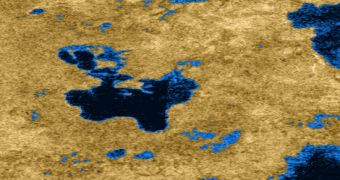Over the past few months, an avalanche of scientific studies on Saturn's moon Titan has been dealing with the prospect that the celestial body is harboring primitive life forms. The investigations have been looking at the chemicals present on the natural satellite, at its temperature, topography and geology, and numerous researchers tried to make educated guesses as to whether life may be possible there or not. Others have drawn parallels to how early Earth looked like, and others still advanced the hypothesis that life may just be teeming on Titan. But there are those who caution against jumping to conclusions.
One of the most telltale signs that life may exist on the moon is the fact that important quantities of hydrogen seem to be falling through the atmosphere, and then disappearing when they reach the surface. “It's the obvious gas for life to consume on Titan, similar to the way we consume oxygen on Earth,” says NASA Ames Research Center (ARC) astrobiologist Chris McKay. Additionally, researchers also found a lack of acetylene on the moon, which may be a clear indicator that life on the surface is using the chemical as an energy source.
This also makes sense because life on Titan would have to rely on methane in order to survive, rather than on water, as it does on Earth. “If these signs do turn out to be a sign of life, it would be doubly exciting because it would represent a second form of life independent from water-based life on Earth,” McKay believes. But not all in the international scientific community are convinced that these phenomena are a sign of life, saying that non-biological explanations can be found for each and every one of them. Numerous experts at various NASA centers also agree with the skeptics.
“Scientific conservatism suggests that a biological explanation should be the last choice after all non-biological explanations are addressed. We have a lot of work to do to rule out possible non-biological explanations. It is more likely that a chemical process, without biology, can explain these results,” said the principal investigator of the Astrobiology Institute Titan team at NASA, Mark Allen. The researchers are currently conducting their studies using numerous datasets collected by the NASA Cassini spacecraft. The probe has been orbiting Saturn since 2004, and has carried out 70 flybys around Titan thus far, with many more planned ahead.
“Titan's atmospheric chemistry is cranking out organic compounds that rain down on the surface so fast that even as streams of liquid methane and ethane at the surface wash the organics off, the ice gets quickly covered again. All that implies Titan is a dynamic place where organic chemistry is happening now,” added US Geological Survey (USGS) Cassini team scientist Roger Clark. Allen said, however, that all the recent speculation, which appeared to take life on Titan as a fact, might be hindering some researchers in keeping an open mind on the subject.
“Typically in the search for the existence of life, one looks for the presence of evidence – say, the methane seen in the atmosphere of Mars, which can't be made by normal photochemical processes. Here we're talking about absence of evidence rather than presence of evidence – missing hydrogen and acetylene – and often times there are many non-life processes that can explain why things are missing,” Allen concludes, quoted by Space.

 14 DAY TRIAL //
14 DAY TRIAL //